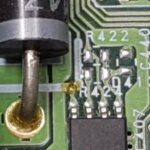The OBDII error code P0606 indicates a problem with the Powertrain Control Module (PCM), specifically a processor fault. This article explains the meaning of the P0606 code, its common symptoms, causes, misdiagnoses, and diagnostic procedures. Understanding this code is crucial for effective vehicle repair and maintenance.
Understanding the P0606 Code
The PCM is the brain of a modern vehicle, controlling vital functions like fuel injection, ignition, transmission, and emissions. It constantly monitors itself through self-diagnostic tests. When a mathematical calculation within the PCM yields an unexpected result, the P0606 code is triggered, signifying a potential issue with the PCM’s processor.
Recognizing P0606 Symptoms
A P0606 error can manifest in various ways, ranging from noticeable performance issues to no apparent symptoms at all. Common indicators include:
- Illuminated Check Engine Light: This is the most common symptom.
- ABS/Traction Control Light: May illuminate due to PCM involvement in these systems.
- Performance Issues: Hesitation, stalling, rough idling, or poor shifting.
- Reduced Fuel Economy: Inefficient engine operation due to faulty PCM control.
- Unusual Symptoms: Rarely, symptoms like dying at stops or misfires can occur.
- No Noticeable Symptoms: In some cases, drivers may not detect any problems.
Common Causes of P0606
Several factors can contribute to a P0606 error code:
- Faulty PCM: The most frequent cause is a malfunctioning PCM processor.
- Wiring/Connection Problems: Damaged or corroded wiring or loose connections can disrupt PCM operation.
- Ground Circuit Issues: A poor ground connection can prevent the PCM from functioning correctly.
- Faulty Output Devices: Problems with components controlled by the PCM (e.g., sensors, actuators) can trigger the code.
- CAN Bus Communication Errors: Problems with the communication network between the PCM and other modules can also cause this error.
Avoiding Misdiagnoses
Misinterpreting the P0606 code can lead to unnecessary repairs. Common misdiagnoses include:
- Attributing Ignition Problems to Other Causes: Overlooking the PCM’s role in ignition control.
- Misdiagnosing Fuel Injection Issues: Failing to recognize the PCM’s control over fuel delivery.
Diagnosing P0606: A Technician’s Guide
Proper diagnosis requires a systematic approach:
- Record All Codes and Freeze Frame Data: This provides valuable context for understanding the error.
- Duplicate the Fault: Attempt to recreate the conditions that triggered the code during a test drive.
- Monitor Key Parameters: Pay attention to engine load, throttle position, RPM, and speed.
- Check for Shorted Output Devices: A shorted component can damage the PCM processor.
- Inspect Wiring and Connections: Look for damage, corrosion, or loose connections.
- Test Ground Circuits: Ensure a solid ground connection for the PCM.
Conclusion: Addressing the P0606 Error
The OBDII error code P0606 signals a potential problem with the PCM’s processor. While a faulty PCM is often the culprit, other factors like wiring issues or faulty output devices can also contribute. Accurate diagnosis is critical to ensure effective repairs. Consult a qualified technician with the appropriate diagnostic tools to address this issue and restore your vehicle’s performance and reliability. A thorough inspection and testing are crucial before replacing the PCM.

